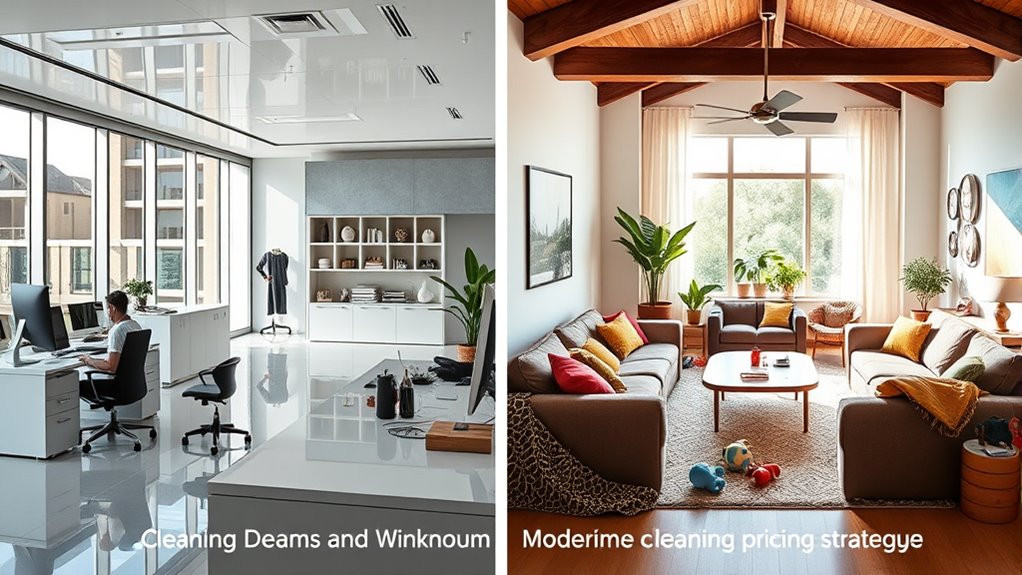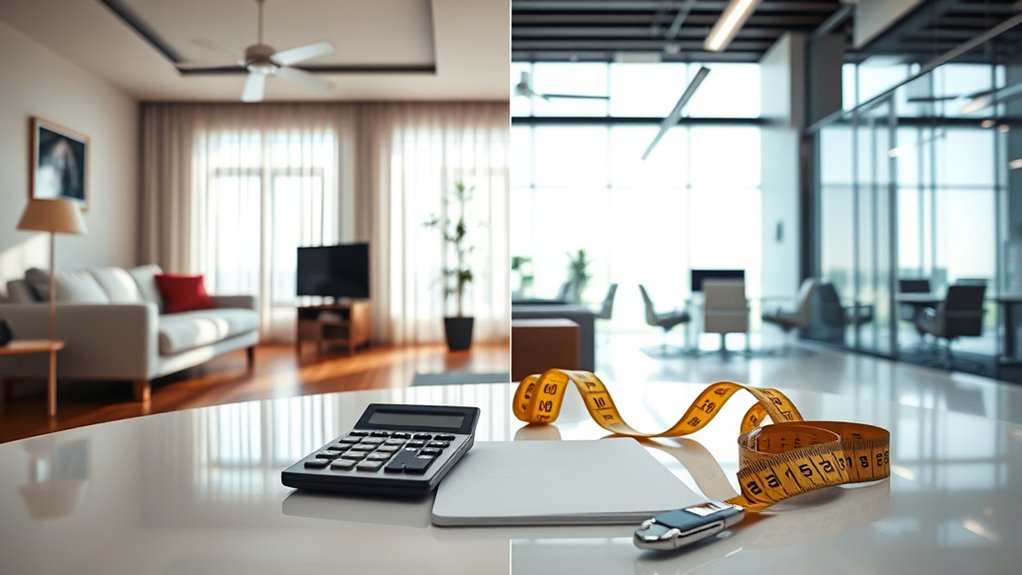To set your cleaning rates effectively, recognize that residential cleaning targets homes and typically commands higher hourly rates, while commercial cleaning focuses on businesses with lower costs. Consider factors like service type, facility size, and the frequency of cleaning. Use methods such as hourly rates or flat fees, and don’t forget to evaluate market trends and client feedback. If you want to optimize your pricing strategy further, there are more insights worth exploring.
Key Takeaways
- Determine your pricing structure based on the type of cleaning: residential rates are generally higher due to personalized services compared to commercial cleaning.
- Assess your operational costs, including labor and supplies, to ensure a profit margin of 15-20% when setting rates.
- Consider facility size and cleaning frequency; larger commercial spaces and regular contracts typically lead to lower rates.
- Utilize market research to identify local pricing trends, ensuring your rates remain competitive and aligned with client expectations.
- Gather client feedback to understand the perceived value of your services, allowing you to adjust rates and offerings accordingly.
Understanding the Differences Between Residential and Commercial Cleaning

When considering cleaning rates, it’s essential to understand the key differences between residential and commercial cleaning.
Residential cleaning typically focuses on individual homes and apartments, offering personalized services that cater to families and individuals. This approach often results in higher hourly rates, which can range from $20 to $50 per cleaner.
On the other hand, commercial cleaning targets businesses like offices, emphasizing routine maintenance and efficiency. As a result, its pricing structure usually features lower rates due to the larger scale of work.
Additionally, the startup costs for residential cleaning are often lower since many supplies may already be available, whereas commercial cleaning requires a larger investment in specialized equipment to meet the unique scope of work for its clientele.
Factors Influencing Cleaning Rates in Residential Services

When setting cleaning rates for residential services, consider the type of service you’re offering and the size of the home.
Different tasks, like deep cleaning versus standard upkeep, can greatly affect your pricing.
Additionally, larger homes typically require more time and resources, which also influences your rates.
Service Type Variations
As you explore cleaning rates for residential services, it’s essential to recognize that various factors influence pricing, including service type and home characteristics.
Understanding these service type variations will help you develop a pricing strategy that works.
Consider these key factors:
- Standard vs. Deep Cleaning: Standard cleaning typically costs $20 to $50 per hour, while deep cleaning services can range from $40 to $100 per hour.
- Frequency of Cleaning: Regular clients may benefit from lower rates per square foot due to economies of scale.
- Additional Services: Tasks like laundry or window cleaning can add $4 to $50 to house cleaning prices.
House Size Impact
House size plays an essential role in determining cleaning rates, impacting both cost and the time required for services. Larger homes typically lead to higher costs due to their square footage.
For instance, cleaning a 2,500-square-foot house may range from $200 to $250 for basic cleaning and $250 to $750 for deep cleaning. In contrast, a smaller one-bedroom home might only cost $50 to $60 for standard cleaning.
Pricing methods often rely on square footage, with average prices for deep cleaning between $0.10 to $0.30 per square foot. Additionally, expect extra charges of $10 to $20 for each additional bedroom or bathroom.
Factors Influencing Cleaning Rates in Commercial Services

When setting cleaning rates for commercial services, you’ll want to contemplate the type of service you provide and how often clients need it.
Factors like location and accessibility can also impact your pricing strategy considerably.
Understanding these elements will help you create competitive and fair rates for your clients.
Service Type Variations
Understanding the variations in service types is essential for setting cleaning rates in commercial settings.
Commercial cleaning differs from residential cleaning in several ways, particularly in pricing systems and service requirements. Here are some key factors to evaluate:
- Facility Size: Larger spaces require more time and resources, impacting average cleaning rates.
- Service Requirements: Specialized services, like post-construction cleanup, can dramatically increase pricing, sometimes reaching up to $800.
- Flat Fee Contracts: These provide predictable costs but may lead to delayed payments, affecting your cleaning business’s cash flow.
Frequency of Cleaning
How often do you think your commercial space needs cleaning? The frequency of cleaning directly impacts your cleaning rates.
Most businesses choose daily, weekly, or bi-weekly services, benefiting from lower rates through regular cleaning contracts. By establishing consistent cleaning routines, you can reduce overall costs, as this minimizes the need for extensive deep cleaning tasks.
Your cleaning frequency should align with your operational needs; high-traffic areas like offices or retail spaces require more frequent attention to maintain hygiene standards.
Plus, many cleaning services offer discounts for clients who commit to regular cleaning schedules, making it financially advantageous.
Ultimately, the scale and usage patterns of your commercial space dictate how often you should schedule cleaning services.
Location and Accessibility
Since location and accessibility greatly influence cleaning rates for commercial services, it’s crucial to take into account these factors when setting your budget.
Here are some key points to contemplate:
- Urban areas often have higher cleaning rates due to increased demand and living costs.
- Accessibility issues, like hard-to-reach locations, can lead to extra transportation costs and time, raising your overall cleaning rates.
- Seasonal demand can impact pricing strategies, with rates spiking during busy periods or special events.
When evaluating your commercial space, remember that larger or more complex areas may require specialized techniques and additional safety measures, further affecting your cleaning rates.
Keep these factors in mind to guarantee you get the best value for your services.
Methods for Calculating Cleaning Costs

When you’re setting cleaning rates, choosing the right method can markedly impact your pricing strategy. You can calculate cleaning costs using various approaches.
For instance, hourly rates for residential cleaning typically range from $20 to $100, depending on the service. Flat rate pricing offers predictability, while per square foot rates average $0.05 to $0.15 for weekly cleaning, with larger homes often costing less per square foot.
Hourly rates for residential cleaning range from $20 to $100, while per square foot averages fluctuate between $0.05 and $0.15.
You might also consider per-room pricing, charging a base fee for one bedroom and bathroom, adding $10 to $20 for extras.
For deep cleaning, hourly rates range from $40 to $100 per cleaner, with flat fees between $200 and $400. Move-out cleaning often follows similar pricing structures.
Evaluating Your Pricing Strategy

Setting competitive cleaning rates is just one part of a broader pricing strategy. To effectively evaluate your pricing, consider these key factors:
- Operational costs: Factor in labor, supplies, and overhead to maintain a sustainable profit margin of 15-20%.
- Frequency of cleaning: Adjust your cleaning pricing based on whether clients opt for recurring services or one-off deep cleans, which typically charge more.
- Client feedback: Continuously tweak your rates according to customer responses and service demand to guarantee satisfaction.
Research local market rates for both residential cleaning ($20-$50/hour) and commercial cleaning ($30-$50/hour) to remain competitive while determining your house cleaning cost and how much you should charge for cleaning.
The Importance of Market Research in Setting Rates

Understanding the local market is essential for establishing competitive cleaning rates that attract clients and sustain your business. Conducting market research helps you identify the average cost of residential cleaning, which usually ranges from $150 to $250.
Analyzing competitors’ pricing lets you gauge the landscape and adjust your rates for profitability. By understanding the demographics of your target market, you can tailor your pricing strategy based on income levels and willingness to pay.
Regularly reviewing market trends, including seasonal demand, keeps your rates aligned with consumer expectations. Ultimately, utilizing customer feedback on pricing and service value provides insights that can refine your offerings, making them more appealing to potential clients in both residential and commercial cleaning sectors.
Adjusting Your Rates Based on Client Feedback and Demand

Adjusting your rates based on client feedback and demand is essential for maintaining a competitive edge in the cleaning industry.
Here are three key strategies to contemplate:
- Gather client feedback through surveys or conversations to gauge their value perception and satisfaction with your cleaning services.
- Monitor local market demand regularly; if demand spikes, it might be time to raise your rates, especially during peak seasons.
- Implement a tiered pricing structure that allows clients to choose between basic and premium services, catering to a broader range of needs.
Frequently Asked Questions
How to Calculate Commercial Cleaning Rate?
To calculate your commercial cleaning rate, start by measuring the square footage of the space.
You can charge between $0.10 to $0.50 per square foot, depending on the building type.
Alternatively, consider an hourly rate of $30 to $50 per cleaner, based on experience and task complexity.
Don’t forget to factor in additional services, like carpet cleaning or window washing, which can increase your total cost.
Always check local market rates to stay competitive.
How to Set Prices for Cleaning Services?
You might worry that setting your cleaning service prices will alienate potential clients, but it’s all about finding the right balance.
Start by researching local market rates and understanding the specific needs of your target customers.
Consider factors like the type of cleaning, frequency, and square footage.
Always be transparent about your pricing and adjust based on client feedback.
This way, you’ll build trust while ensuring your business remains profitable.
What Is the Difference Between Commercial Cleaning and Residential Cleaning?
When you think about the difference between commercial cleaning and residential cleaning, consider the environments involved.
Commercial cleaning targets non-residential spaces like offices and schools, while residential cleaning focuses on homes.
You’ll find that residential cleaning often demands a more personalized touch, while commercial cleaning prioritizes efficiency and routine tasks.
Additionally, commercial contracts can provide you with stable income, as businesses typically have cleaning budgets in place.
Should I Start a Residential or Commercial Cleaning Business?
If you’re weighing your options between starting a residential or commercial cleaning business, think about what suits your style.
Residential cleaning lets you build personal connections with clients, while commercial cleaning offers steady contracts and dependable income.
Consider your passion for customer relationships versus your preference for structured work environments.
Both paths have their perks, so choose the one that excites you and aligns with your goals for long-term success.
Conclusion
In the world of cleaning, finding the right balance in your rates can feel like a dance. By understanding the nuances between residential and commercial needs, and keeping an ear to the ground for client feedback, you can gracefully adjust your pricing. Embrace the ebb and flow of market demands, and you’ll not only attract the right clientele but also cultivate a thriving business. Remember, a thoughtful approach to your rates can lead to a sparkling future.










